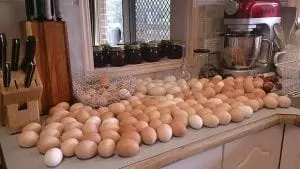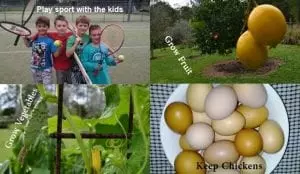Turn 1kg of potatoes into 20kgs without divine intervention! Growing potatoes isn't difficult no matter where you live. It's just a matter of timing, a little digging, some potato food, and then a few short months of growing for you to produce the best tasting taters you'll ever eat.
Just a few articles back I wrote about sweet potatoes so I was going to mix it up and write about something other than another root vegetable; however, I had just lifted my potatoes for this season and I thought it was a great opportunity to showcase my bounty.
Potatoes
So potatoes are a root crop we know that; but, potatoes actually belong botanically to a family of plants called solanaceae, which group together many plants including t omatoes, egg plant and tobacco. If you have the patience or lack garden space a potato and tomato plant can be grafted together producing both tomatoes on top and potatoes below. Although, I have never grafted potatoes and tomatoes together and nor have I heard of any big success stories about people who have gone through the trouble; nevertheless it is possible.
omatoes, egg plant and tobacco. If you have the patience or lack garden space a potato and tomato plant can be grafted together producing both tomatoes on top and potatoes below. Although, I have never grafted potatoes and tomatoes together and nor have I heard of any big success stories about people who have gone through the trouble; nevertheless it is possible.
Types
There are many different types of potatoes: some are small; shapely; coloured (like red); some good for mashing; others good for roasting; and some selected for commercial reasons like the large sized Russet Burbank used by McDonald’s.
To me, a potato is a potato and I like all sorts but I can't say I really taste a huge difference between one variety to another (unlike some other fruits and vegetables). Some people swear by certain varieties for certain cooking methods and recipes; for instance, the red varieties are supposedly best for potato salad or a higher starch variety can make for a smoother mash. Truth is – I personally don't know. I'm no potato connoisseur; nevertheless, I do like growing them and fresh potatoes (no matter what type) straight out of the garden are delicious.
Growing Potatoes

Growing potatoes is easy if we stick to a few principals:
-
Timing – Firstly, to grow potatoes successfully they need to be grown at the right time of year – this is the critical factor. For a potato crop to survive and flourish long enough to form good quality tubers the plants need a growing season of approximately three – four months free from frost and high humidity. This means in cool regions planting should be done from spring onwards (once all frosts are definitely over as frost will kill the tender plant) then harvesting can commence in summer/autumn. In warm regions, potatoes should be sown in autumn/winter for harvest in spring before the big rains hit otherwise the extra water and high humidity will cause tubers to rot and the plant to develop fungal diseases like potato blight.
-
Potato seed – Or chitted potatoes (meaning the tubers are left exposed to light until they start to shoot from the eyes) can be purchased as certified disease free or saved from last seasons harvest. If you are using your own potatoes from last season:
-
Select your seed potatoes carefully and try to choose medium sized tubers that are free from disease, open wounds, or blemishes; and
-
Try to chit them in a place where the tubers can receive some direct sunlight so the shoots develop a strong dark appearance (rather than an anaemic light-deprived look).
-
Chitting can take one or two weeks and when the shoots are an inch or few centimetres high they're right to plant out. Sometimes when I plant bought seed, I don't chit the tubers any further at all and I have had good results by just bunging them straight in the ground from the packet without further ado. But, I guess ensuring a tuber has started growing before planting is good practice.
-
-
Planting – Potatoes can be grown several ways the most common are:
-
Containers

-
With a light soil or potting mix – fill a 40cm (16”) container about 1/3 with potting medium and place two (more depending on size of pot) seed potatoes 6 inches apart on top. Sprinkle about a hand-full of blood and bone fertiliser around the potatoes and then cover with 4 inches of soil. When the plant reaches the top of the pot add some more potting medium leaving about 6 inches of foliage above the soil. Water regularly and let the plant grow.
-
No dig – use a straw, compost, mulch, or mixture of all as the growing medium. Layer some well decayed manure between the medium levels in the container and layer up to about 1/3 then add the seed potatoes. Continue to layer until the potatoes are well covered. As the plant grows keep layering to the top of the container ensuring tubers are covered in a thick mulch to prevent sunlight exposure.
-
-
Garden bed in separate holes – dig a hole about 12 inches deep and the same wide in some crumbly soil with added compost and/or manure. Place one or two seed potatoes in the bottom, throw in a little blood and bone and cover with about 4 inches of soil. As the plant grows backfill with the soil dug from the hole until the plant is at
 ground level or if you have some spare soil you can heap-up the dirt around the stem a little to encourage more roots and ensure no potatoes are exposed.
ground level or if you have some spare soil you can heap-up the dirt around the stem a little to encourage more roots and ensure no potatoes are exposed. -
Garden bed in a row “trench style” – this is my favourite way and is similar to above but instead of separate holes dig a trench about a foot deep (12 inches). Place seed potatoes along the trench bottom about 12 inches apart and again sprinkle some fertiliser then cover with soil and manage as above.
-
-
Harvesting
-
After about three months the plants will have matured and should be in the final stages of tuber swell. The plant may flower (similar to a tomato), which is usually a sign the tubers should be ready. I let my plants die off (som
 etimes until the plant is completely brown and dead) then I carefully dig the tubers with a garden fork by coming in from the side of the trench to try and limit damaging any tubers. Tubers shouldn't be far from the centre of the stem but ensure to dig around and locate any stragglers. How many potatoes? Several potatoes per plant is normal but a better indication is weight per seed at planting and turning 1kg of potatoes into 20kg is achievable and pretty good value I think.
etimes until the plant is completely brown and dead) then I carefully dig the tubers with a garden fork by coming in from the side of the trench to try and limit damaging any tubers. Tubers shouldn't be far from the centre of the stem but ensure to dig around and locate any stragglers. How many potatoes? Several potatoes per plant is normal but a better indication is weight per seed at planting and turning 1kg of potatoes into 20kg is achievable and pretty good value I think. -
Potatoes can be harvested during the growing period if small tubers are desired and you can check the size by carefully digging around the base of the plant. Also, unforeseen weather conditions like excess rain or late frosts may upset the growing period – no matter, just dig-up the tubers and salvage what you can and replant if there's time or have another go next season.
-
A few things to remember about growing potatoes:
-
Remember to plant the chitted potato with the shoots pointing upward.
-
Remember to mound the soil up around the base of the
 plant to ensure tubers are not exposed to light. If tubers are exposed to light they will turn green and become poisonous – if any potatoes close to the surface show signs of green do not eat them.
plant to ensure tubers are not exposed to light. If tubers are exposed to light they will turn green and become poisonous – if any potatoes close to the surface show signs of green do not eat them. -
Remember not to over-water potatoes as this just encourages disease. Also, try to rotate potatoes in different beds each season to help limit a build-up of soil-borne diseases.
-
Remember to feed potatoes when first planted with some well rotted manure and/or fertiliser. Don't over-feed throughout the growing period but a little drink of a soluble fertiliser like seaweed is ok once or twice.
-
Remember potatoes like a slightly acid soil so lime before planting isn’t necessary.
Storing Potatoes
Potatoes are a high energy food and a super carbohydrate source able to sustain populations. The tubers also store really well, and are a “perfect 10” from an agricultural perspective for machine planting/harvesting, which is what makes them such a valuable food crop to grow.
Storing potatoes:
-
For eating – store unwashed in a cool, dark, airy place in a hessian bag or woven container. Check occasionally and remove any tubers showing signs of rot otherwise the rot may spread to other potatoes.
-
For next season planting – store in a container covered in soil in a cool, dark, airy place. I often store mine in a cardboard shoe box or wooden crate but the example below shows storage in a plastic bucket. I keep the eating potatoes in the pantry and I store the seed potatoes in the garage.
Select Potatoes for Seed Keeping

Place in container with soil on bottom

Cover with soil and add another layer (if room allows)

Put seed and eating potatoes in dark airy place

A shoe box is a cheap alternative for storage

Eating
I think we all know how to cook potato. If you ever have any roasted potatoes left over from a Sunday dinner, cold roasted potatoes with a little salt are an easy and healthy snack for  school lunches on Monday or just for yourself (try them cold with some Worcestershire Sauce).
school lunches on Monday or just for yourself (try them cold with some Worcestershire Sauce).
Most people love hot potato chips (I like mine sprinkled with salt and a few drops of vinegar) it takes me back to my teenage years at the annual Toowoomba Carnival of Flowers where a hot bucket of chips complemented the cool evening walking around looking at the amusement rides.
Summary
The potato is another vegetable heavy weight, which is suitable for the self sufficient home gardener to grow. The plant is compact, able to be grown in containers or the ground, and there are many fun varieties to try (different to the usual shop varieties).
For successful growing, timing is essential especially in cool or hot climates due to the fragility of the plant and susceptibility of tubers to rot if left underground. But, the storage capabilities of the vegetable once harvested means potatoes are an e xcellent source of food for many months without the requirement to preserve.
xcellent source of food for many months without the requirement to preserve.
So, I urge you to give growing potatoes a try and then eat them any way you choose because home-grown potatoes are simple to do and delicious no matter what variety or how they're cooked.
Feel free to use the comment section below and have your say (no email is required).
Thanks for reading and thanks for your support,
Look, and see the Earth through her eyes
Mark Valencia – Editor SSM


 ground level or if you have some spare soil you can heap-up the dirt around the stem a little to encourage more roots and ensure no potatoes are exposed.
ground level or if you have some spare soil you can heap-up the dirt around the stem a little to encourage more roots and ensure no potatoes are exposed. 
 plant to ensure tubers are not exposed to light. If tubers are exposed to light they will turn green and become poisonous – if any potatoes close to the surface show signs of green do not eat them.
plant to ensure tubers are not exposed to light. If tubers are exposed to light they will turn green and become poisonous – if any potatoes close to the surface show signs of green do not eat them. 











